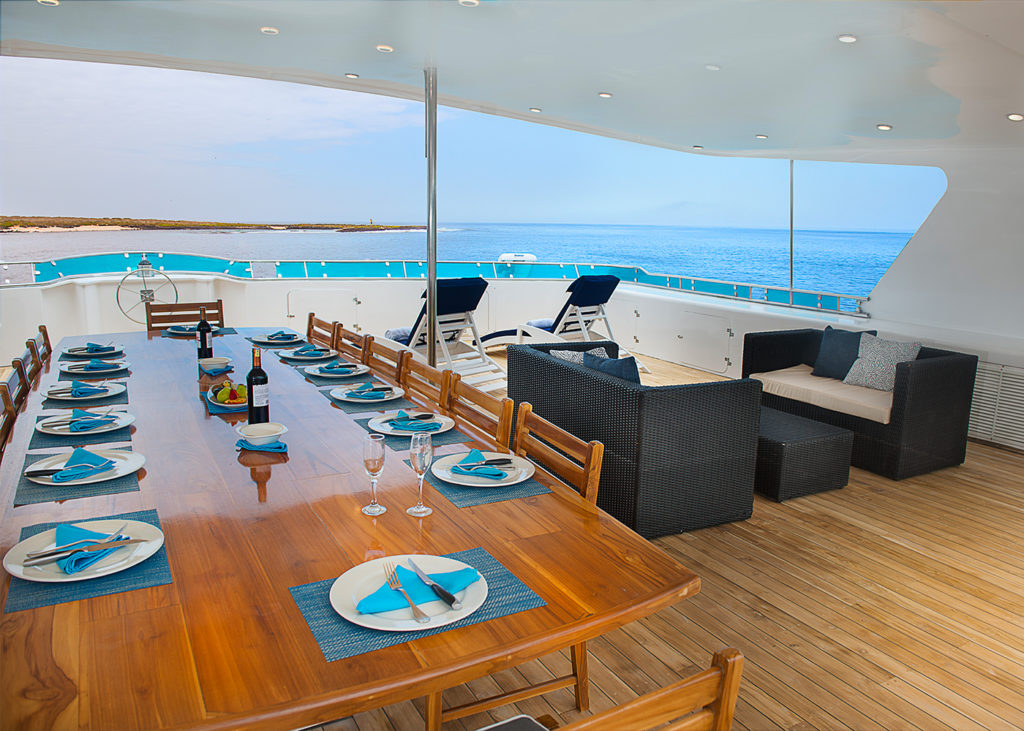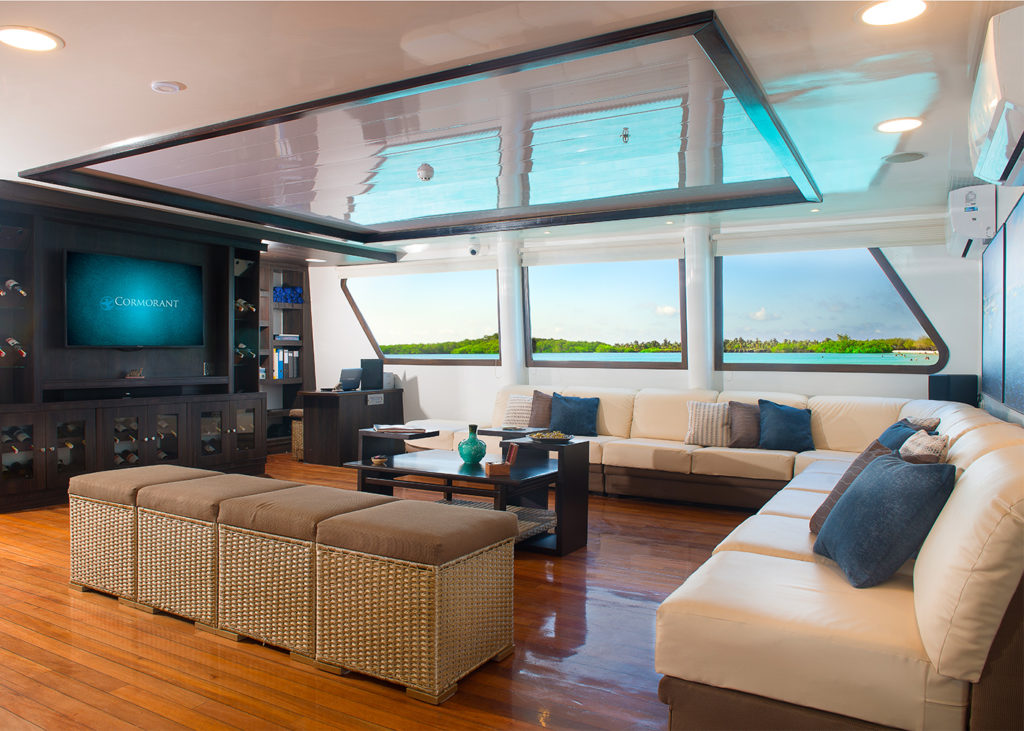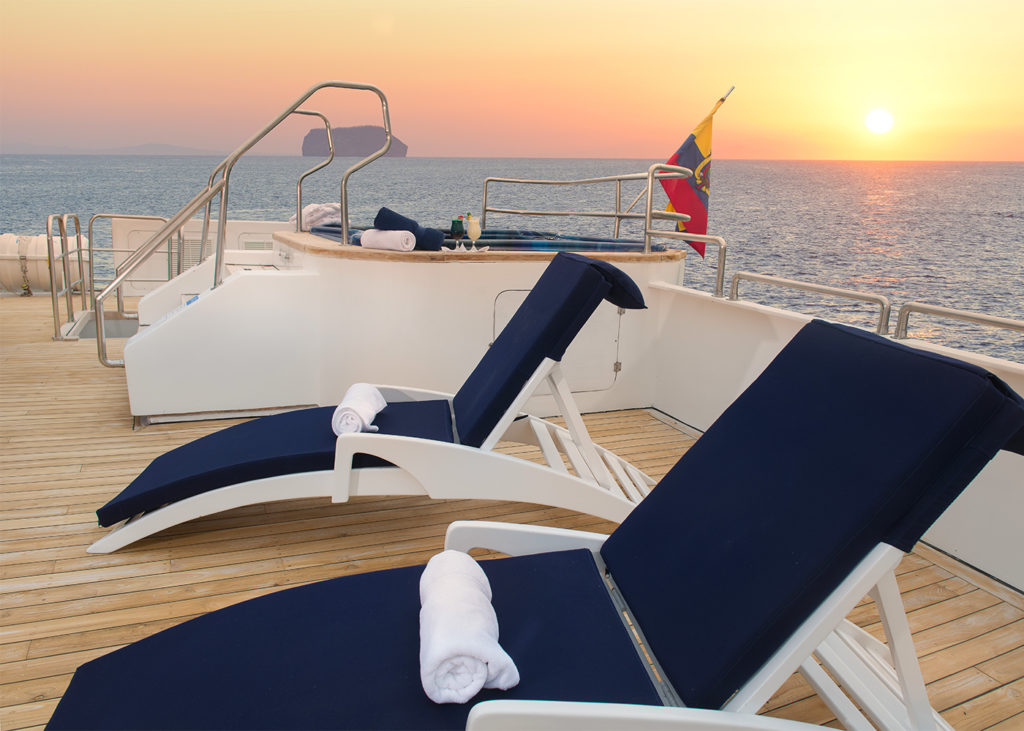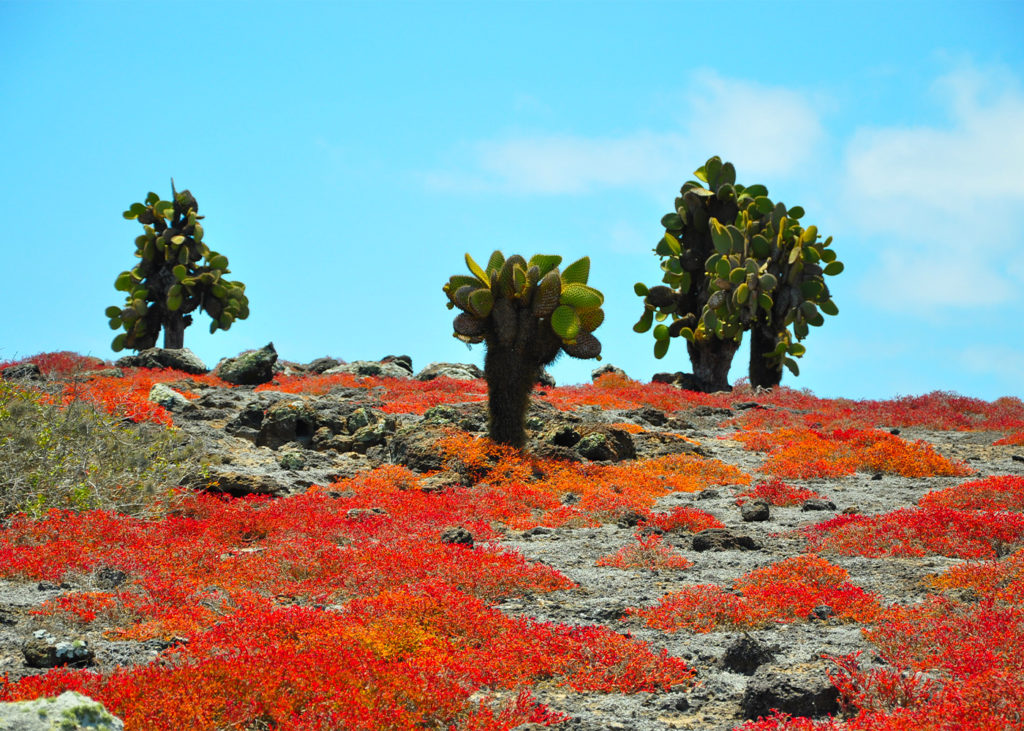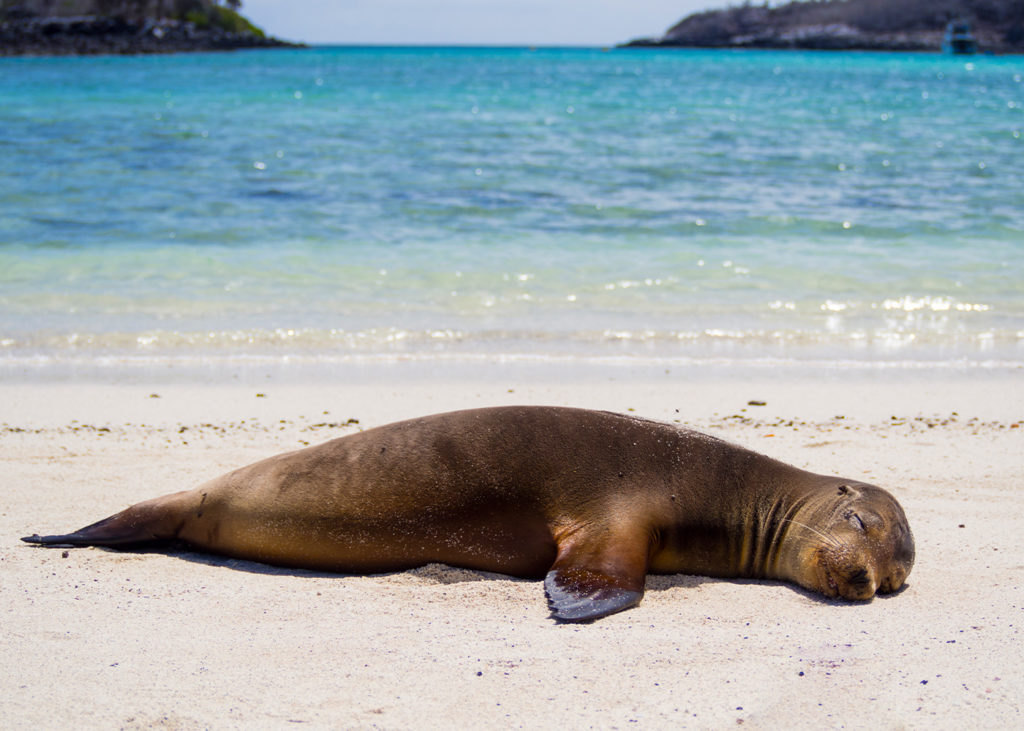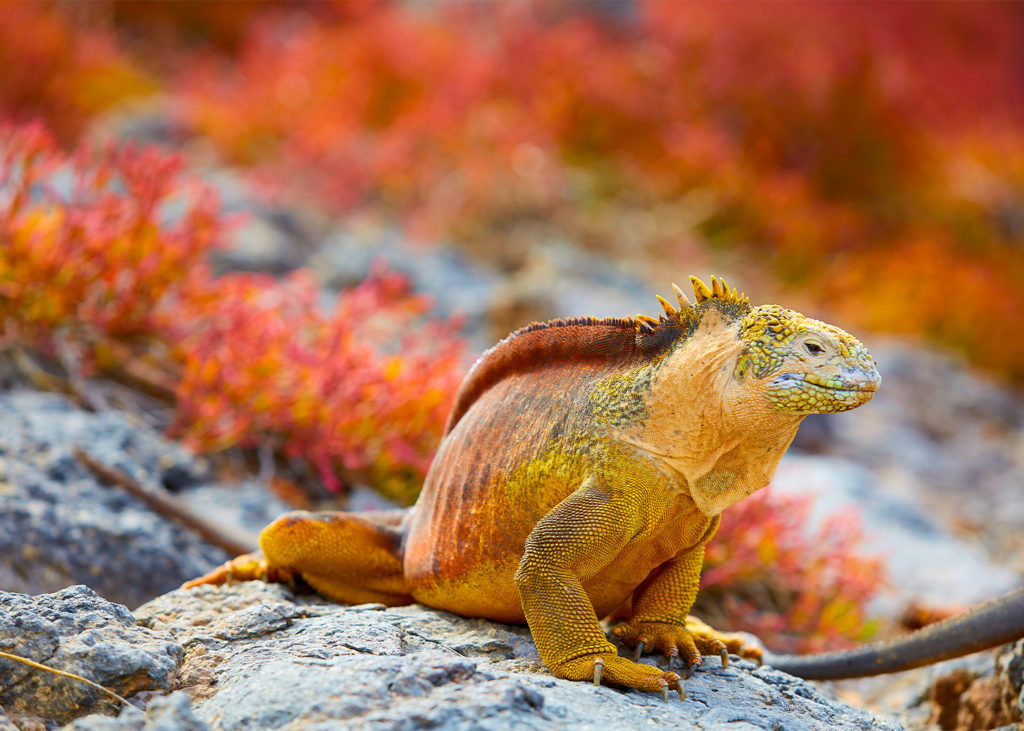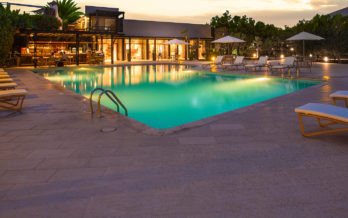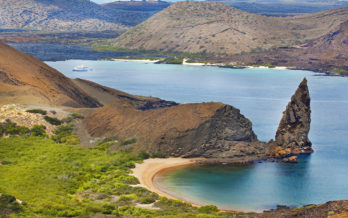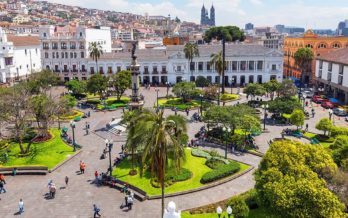Cruise Overview
This beautiful 16 passenger vessel has been recently remodeled offering to your clients the following features:
- All cabins and suites with panoramic ceiling to floor windows and private balconies
- Beautiful dinning area with panoramic windows
- Renovated sun deck with a comfortable al fresco dining and an 8 passenger jacuzzi on the stern area
- 2 comfortable suites with a spacious lounge
- 4 interconnected cabins on the upper deck
Cabins
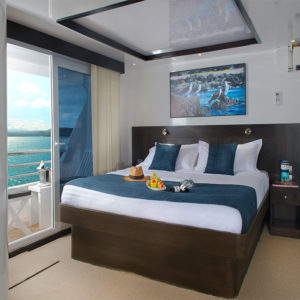
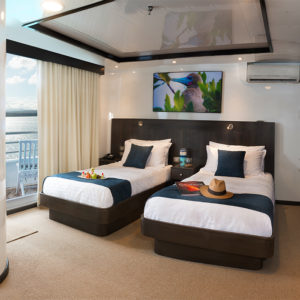
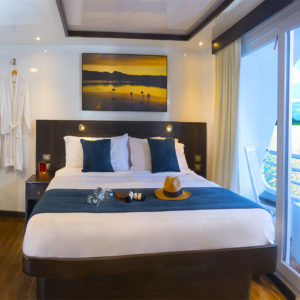
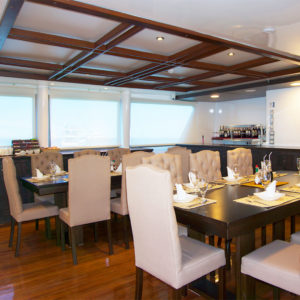
Central & Western Islands Itinerary
Departs Saturdays
Upon arrival to the airport in Baltra you will be greeted by our staff and taken across the Itabaca Channel to visit the Island of Santa Cruz before boarding. The visit includes a short hike. Dress appropriately with sturdy shoes, long pants, and a long-sleeved shirt due to the climate of this area.
On Santa Cruz you will see a unique ecosystem, the highlands, which consists of a humid cloud forest where giant tortoises dwell and birds find sanctuary. This ecosystem contrasts with the dry coastal areas of the islands and the beautiful white sandy beaches, characteristics of the volcanic Islands.
A delicious box lunch will be served and afterwards we will visit the town of Puerto Ayora before embarking. Once on the Cormorant Yacht you will have time to settle in and make yourself at home.
In the morning we will visit the Tintoreras Islet, located a short distance from Puerto Villamil and is the home to a great variety of wildlife. Its turquoise, crystalline waters are inhabited by white-tipped reef sharks, Galapagos Penguins, marine turtles and sea lions. One of its beaches, surrounded by mangroves is one of the few sites where marine iguanas can reproduce successfully.
The afternoon visit will head to Sierra Negra. The Sierra Negra Volcano boasts the largest basaltic caldera in Galapagos at 9 x 10km. The site offers impressive views and the opportunity to observe up to 7 species of finch and a rich display of vegetation. The north side of the caldera provides evidence of its most recent volcanic activity in 2005.
In the morning we will visit Moreno Point, located south west of Elizabeth Bay. Here, a dry landing onto what was once flowing lava is possible. The lava has left craters in its wake, which formed crystal tide pools. By looking into the pools, you can peer into another world, as the marine life drifts by your window. In the brackish pools of this area, you may see pink flamingos, White-Cheeked Pintails, and Common Gallinules. If you look carefully into the pools you may see white tip reef sharks and some sea turtles.
The afternoon visit will take us to Elizabeth Bay, a secluded space lacking any landing sites. We will take a traditional ‘panga’ ride, passing the red mangroves and amongst the wildlife of the lively bay. Elizabeth is known for its marine life; you will probably see sea turtles and rays skimming the surface of the water. You may also see the Brown Pelicans diving for fish, penguins, Blue-footed Boobies & possibly spot humpback whales.
In the morning we will head for Mangle Point. No foreign species have ever invaded Fernandina Island and therefore it is one of the world’s most pristine island ecosystems. The volcano “La Cumbre” dominates the landscape with lava fields reaching the ocean. The island’s highlight features the Flightless Cormorant nesting site. This area provides a great opportunity to see the Galapagos Hawk.
In the afternoon, we will land at Urbina Bay which presents some fascinating geological formations. In 1954, an uplift from the sea formed the bay; which has been characterized by the resulting terrestrial coral reef ever since. Expect to see stingrays and sea turtles swimming near the surface of the water, along with Flightless Cormorants, pelicans, and marine iguanas. You will be dazzled by the breathtaking view of the Alcedo Volcano.
Fernandina Island: No foreign species have ever invaded this island and therefore it is one of the world’s most pristine island ecosystems. Fernandina is the youngest island in Galapagos. Access to this site is extremely restricted by the Galapagos National Park and you will be one of those very lucky visitors. The volcano “La Cumbra” dominates the landscape with lava fields reaching the ocean.
Crossing the Bolivar Channel that divides Isabela and Fernandina Islands we will land at Espinosa Point, and after walking past a colony of marine iguanas and a group of sea lions, reach the island’s highlight: the Flightless Cormorant nesting site. This area provides a great opportunity to see the Galapagos Hawk.
In the afternoon we will visit Isabela Island once again to Vicente Roca Point. Comprised of two separated coves, this site is a large bay with spectacular sea life. Keep an eye out for seahorses, sea turtles, and the strange yet fascinating Mola-mola sunfish.
Our morning visit is to a site called Egas Port, also known as James Bay, on Santiago Island. Here, you will enjoy a hike over a dry trail known for being a hang-out for curious Galapagos Hawks and Quick-footed Galapagos Lava Lizards. The trail will then lead you to the coastline where you will visit the gorgeous tide pools and Grottos which are full of fauna. You will be able to observe the shy Galapagos fur sea lions. You will also get to snorkel at Egas Port beach.
In the afternoon we will visit Espumilla Beach where marine iguanas lounge and the Sally Lightfoot Crabs attract the hunting herons, performing the dance of predator and prey right before your eyes. Snorkelling is highly recommended as you could find yourself face to face with an octopus, moray eel, shark, or a variety of other species of tropical fish.
Buccaneer Cove is a testament to the fact that Santiago Island was once a refuge for British buccaneers. They would anchor in the protected bay to make repairs and stock up on tortoise meat among other things. It is an excellent opportunity to take in the steep cliffs, where hundreds of seabirds perch in front of the dark red sand beach. See if you can spot ‘Monk’ or ‘Elephant’ Rock before your guide points them out!
The morning takes us to El Barranco, also known as Prince Phillip’s Steps, whose steep, rocky path will lead you up 25 meters (82 mi) of cliff-face. After marveling at the view you will have the opportunity to take a (0.6 mi / 1 km) trek through Palo Santo vegetation. Here you will be dazzled by all the birds: Red-footed Boobies, Short-eared Lava Owls, Galápagos Swallows, and Galápagos Doves are abundant.
Our afternoon visit will take us to the beach at Darwin Bay. This white-sand coral beach heads a (1/2 mi – 3/4 km) trail that winds through mangroves that are filled with land birds. You may see Nazca Boobies, Red-footed Boobies, and Swallow-tailed Gulls. Further down the path, you may see sea lions playing in tidal pools. You will arrive cliff-side and can let the spectacular views soak in, while the Boobies and iguanas keep you company.
The morning visit will take us to North Seymour Island. Galapagos Sea Lions, Blue-footed Boobies and Magnificent Frigate birds are abundant on North Seymour Island. The island was formed by series of submarine lavas containing layers of sediment that were uplifted by tectonic activity. The island is characterized by its arid vegetation zone.
After this final visit, you will be transferred to Baltra’s airport in time to catch your flight back to the mainland.
Southern Islands
Departs Wednesday
Morning flight from Quito or Guayaquil to the Galapagos Island of San Cristóbal. Meet your guide at arrivals and transfer to the Cormorant. You will be shown to your cabin where you will have some time to settle in before lunch and a welcome briefing. In the afternoon, take a dinghy ride and go snorkelling around Kicker Rock. You will see the Galapagos natural monument, the remains of a lava cone eroded by the sea, frequented by tropical birds, as well as two vertical rocks rising 500 feet above the ocean that form a small channel that is navigable by small boats.
Española is densely populated with mockingbirds, blue-footed and nazca boobies, darwin finches, Galapagos doves, hawks, red and green marine iguanas, and plenty of sea lions. In the morning arrive at Suarez Point which is great for spotting blue footed boobies, albatrosses and Nazca boobies. You will see a beautiful site on the ocean front, where the large waved albatross uses the cliff as a launching pad. The famous attraction is the magnificent blowhole, spurting water high into the air. Gardner Bay, on the eastern side of the island, is the breeding site of nearly all of the world’s 12,000 pairs of waved albatross. It has a white sandy beach with a myriad of sea lions, perfect for relaxing. Its rocky shores make this site a great place for diving and snorkelling.
Today, visit two sites on Floreana Island, Post Office Bay and Cormorant Point. Floreana is known for its fabulous snorkelling sites, its vibrantly pink flamingos and its black sand beaches. You will land on a beach and head to a spot where 18th century whalers placed a wooden barrel for use as an unofficial mail box which continues today, so don’t forget your postcards! In the afternoon, head to Cormorant Point for a hike to the salt water lagoon which is home to flamingos. You will also get to swim in Champion, one of the best snorkelling sites in the Galapagos Islands.
In the morning, visit the Charles Darwin Station Breeding Centre, home to many turtles. The older turtles are accustomed to humans, and will stretch out their heads for a pet. The babies are only kept until they are about four years old, or large enough to survive in the wild. These conservation efforts continue to be extremely successful. After this final visit, you will be transferred to Baltra’s airport in time to catch your flight back to the mainland.
Tour Inclusions
- All meals throughout cruise
- Transfers in the islands
- Bilingual national park guide
- Use of snorkeling equipment and wetsuit
- Use of Underwater Camera
- Free airport assistance when purchasing a roundtrip airfare from SATO
- 1 hotel night in Quito or Guayaquil (the day before the cruise) when purchasing a roundtrip airfare from SATO
Tour Exclusions
- Flights to Galapagos from mainland Ecuador
- Alcoholic drinks
- Galapagos National Park fee
- Transit Control Card
- Tips
